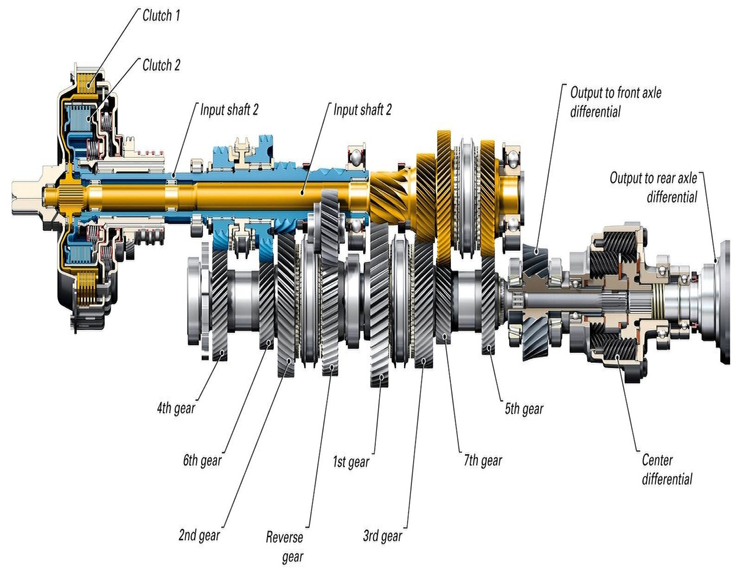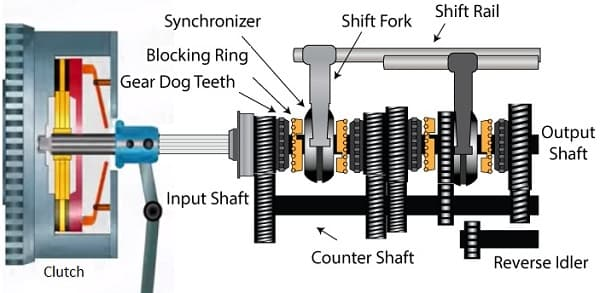
A manual transmission is a house of various components like gears, shafts and various selecting mechanism that is arranged in special fashion to provide appropriate torque and speed ratios to compete with the challenges provided by the different road conditions, the shifting from high torque to high speed and vice-versa is performed manually by symmetrical pushing and pulling of the gear lever by the driver.
The vehicle with MT usually comes with an n-speed manual with or without reverse configuration where ‘n’ denotes the number of speed ratios or shifts for example-Maruti Suzuki swift comes with 5-speed 1-reverse manual transmission.

COMPONENTS OF A MANUAL TRANSMISSION
1. Clutch Pedal:
The clutch pedal is a hydraulically controlled piece of gear that disengages the clutch when you depress it.
2. Clutch:
This is a system of components which is used to transmit engine torque to the transmission. It consists of a pressure plate, diaphragm spring, clutch disc, throw-out bearing, and other smaller components. The clutch disc is a friction pad which is sandwiched between the flywheel and the pressure plate.
3. Flywheel:
As it relates to manual transmissions, the flywheel is the component which delivers engine torque to the clutch disc. This circular mass has a smooth surface which the clutch disc interacts with.
Understanding how a clutch works are fairly important to understanding the transmission overall.
4. Selector Fork
This arm is used to move the collars along the output shaft (to select gears) and can be moved using the gear shift.
5. Collar(s)
The collar is what is used to select different gears. It slides between gears and can mesh with them. The collar is splined to the output shaft, whereas the gears rotate with the layshaft (and thus are on bearings on the output shaft). By locking the collar with a selected gear, engine torque passes from the layshaft to the output shaft.
6. Synchronisers
These are located between the gears and the collar and allow for the collar to engage the gear even if there is a speed differential between the two. Essentially, this aids in matching the speed of the gear and the collar.
7. Shafts
There are usually 3 shafts used in a manual transmission those are-
(i) Main-Shaft-
It is the shaft that is also called the output shaft and is placed in front of the clutch shaft and in parallel to the lay-shaft. Gears, gear lever along with the meshing devices such as dog clutches and synchromesh devices are mounted over this shaft.
(ii) Lay-shaft or Counter Shaft-
It is the shaft used as an intermediate shaft between the clutch shaft and the main shaft, it is usually mounted below and parallel to the main shaft, and act as an engine output carrier from the clutch shaft to the main shaft.
(iii) Clutch-Shaft-
It is the shaft that carries the rotational output from the engine’s flywheel to the transmission with the help of clutch that engages and disengages the output from the engine.
8. Gears
Various sized gears are used to allow for different wheel speeds. Larger gears will provide more torque but have lower maximum speeds. Smaller gears (with fewer teeth) will provide less torque but will allow the car to travel at a higher speed.
There are mainly 4 types of gears used in the manual gearbox those are-
(i) Spur Gear:
Used in old sliding mesh gearbox these types of gears have straight cut teethes.
(ii) Helical Gear:
They are the modified version of the latter as they have angular cut teethes.
(iii) Bevel:
They are best of all above gears having a conical cross-sectional area with angular cut teethes.
(iv) Idler-gear:
It is the small gear used as a reverse gear usually mounted over the layshaft.
TYPES OF MANUAL GEARBOX USED
There are 3 types of manual gearboxes used since the introduction of the transmission that is-
1. Sliding Mesh Gearbox
This is the oldest type of gearbox used. In this type of gearbox shifting occurs by the sliding of gears over the splined main-shaft in order to mesh with the appropriate gear on the lay-shaft whose one gear is in constant mesh with the clutch shaft gear in order to carry rotational motion for the conversion(high torque or high speed)as required by the drive, this gearbox requires special technique for the shifting that is usually known as double-declutching and also the meshing was so noisy and harsh, that gives rise to the development of a new gearbox system.
Note-They usually came with the max of 3-speed manual shifts.

2. Constant Mesh Gearbox
This is the modified version of the later which was introduced to over the limitations of the later, in this type all the gears on the main-shaft, lay-shaft and clutch-shaft are in constant mesh with each other and the selection of the appropriate gear is done by the special meshing devices known as dog clutches which slides over the splined main-shaft in order to select the appropriate gear as need by the drive. This system flushes away the double-de-clutching problem and made the drive less noisy as the spur gears of the sliding mesh is replaced with the helical or bevel gears ,but the shifting of gear is still not smooth and also there is a lot of wear and tear of the dog clutches due to the different rotational speed of the shafts while meshing, which leads to the high maintenance.
Note – it came with 4 or 5-speed 1-reverse manual shift configuration.
3. Synchromesh Gearbox
This is the latest type of gearbox used from decades as this system overcomes all the limitations provided by the constant mesh gearbox or sliding mesh gearbox and also improves the output capabilities of the manual transmission system, in this type the dog clutches from the constant mesh gearbox is replaced by the synchromesh devices which first bring the main-shaft and lay-shaft at same speed by the frictional contact, then meshing of the appropriate gear occurs which makes the system smooth and also decreases the maintenance of the gearbox, today this system usually comes with 5-speed 1-reverse manual transmission configuration.
Note-it is coming with a 5-speed 1-reverse configuration.
WORKING OF MODERN MANUAL TRANSMISSION

Today almost all the vehicles with a manual transmission on the road are equipped with synchromesh gearbox as it is more reliable, needs less maintenance, and the selection of gear is not complex with This type of gearbox whose working is as follows-
• When the driver presses the clutch pedal in order to shift the gear, the disengagement of the engine flywheel and clutch shaft occurs which lets the driver select appropriate gear according to the need of the drive.
• When the gear lever is pushed or pulled by the driver in order to select the particular gear, the synchromesh device which is attached to the particular link slides towards the selected constantly meshed pair of gears.
• At first, this synchromesh device makes the frictional contact with the selected pair and the shafts in order to bring the rotating shafts at the same speed.
• Then the pair of gears having an appropriate gear ratio has meshed with the synchromesh device in order to obtain output given by the pair of gears, which is then transferred to the main shaft.
• Then this output with appropriate torque or speed is transferred to the final drive when the driver releases the clutch pedal which completes the shifting of gear.
• When it comes to the selection of reverse gear the contact of the synchromesh device is made with the idler gear which in turn reverses the rotation of the main shaft and the drive starts moving in a reverse direction.
Note – As constant meshing of gears and Continuous sliding of synchronizing devices is there so constant supply of lubricating oil should be there in order to avoid wear and tear of the components of the manual transmission.
APPLICATION

Specifically, manual transmission covers 52% of the total automobile market which means more than half the vehicle on the roads is equipped with MT.
1. All the heavy vehicles such as trucks, loaders, etc. Are equipped with MT.
2. Almost all the bikes on the road are having a manual gearbox with usually 4 or 5-speed shifts with no reverse.
3. The formula race cars use a manual transmission with quick response shifting mechanism.
4. Almost all commercial cars use MT due to their low cost except high-end cars like Audi, BMW, etc.
(Automotive World)

Buenos días muy interesante la información pero está en inglés, necesito descargar la información, como hago ?